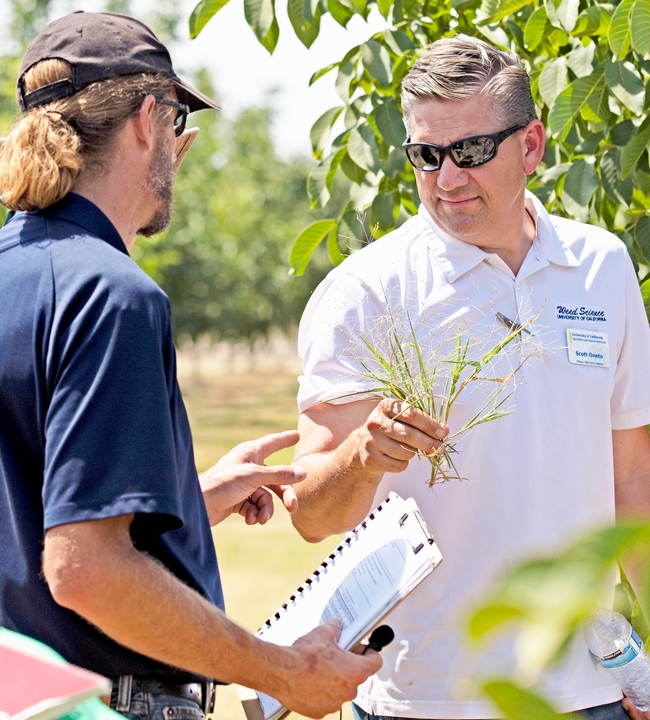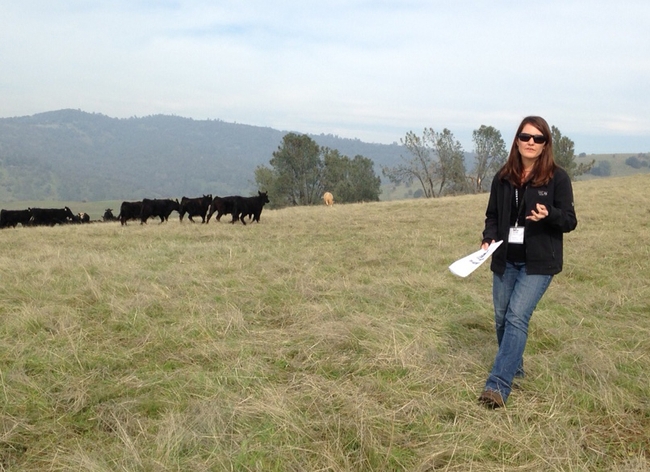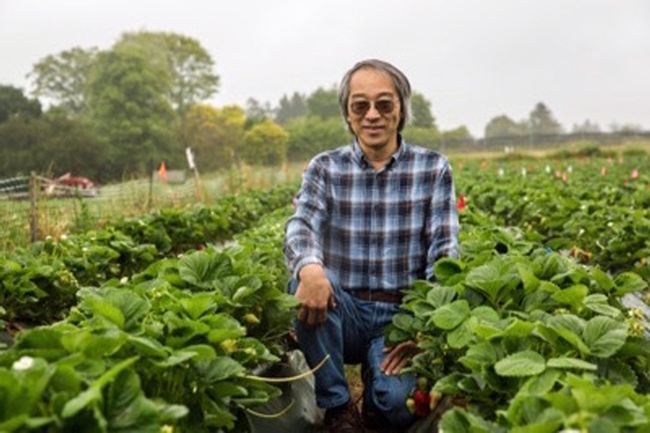Posts Tagged: specialist
UC ANR to recruit 16 new UC Cooperative Extension Specialists
University of California Agriculture and Natural Resources will be recruiting 16 new UC Cooperative Extension Specialists over the next 12 months. This is in addition to the five UCCE Specialist positions released for recruitment last fall and two co-funded UCCE Specialist positions since May 2021 – one in partnership with UC Merced and another with UC Davis School of Veterinary Medicine.
To date, 106 UCCE Specialist and Advisor positions have been released since spring 2021, thanks to increased 2021-22 state funding. The positions are located in communities across California.
“We are positioned to make an even bigger difference in the lives of Californians by having so many more boots on the ground,” said Glenda Humiston, UC vice president for agriculture and natural resources.
UCCE Specialists perform research on campus with other campus-based academics and in the field with UCCE Advisors, who work directly with farmers, families and other Californians.
Currently UC ANR has UCCE Specialists located on six campuses – UC Berkeley, UC Davis, UC Riverside, UC Santa Barbara, UC Santa Cruz and UC Merced – at UC ANR's research and extension centers and in county offices.
“We are excited to strengthen partnerships with additional UC campuses by placing UCCE Specialists at UC Irvine and UCLA for the first time,” Humiston said. “We are also adding a position in UC Berkeley's School of Public Health.”
The new UC Cooperative Extension Specialist positions are listed below:
- Agricultural Toxicology Specialist, UC Davis School of Veterinary Medicine Molecular Biosciences and CAES Department of Environmental Toxicology
- Agroecology Specialist, UC Santa Cruz Center for Agroecology and Department of Environmental Studies
- Climate Resilience and Labor Specialist, UC Berkeley School of Public Health
- Dairy Cattle Production Health and Management Economics Specialist, UC Davis School of Veterinary Medicine Teaching & Research (located in Tulare County)
- Diseases of Nursery Greenhouse and Native Crops Specialist, UC Davis Department of Plant Pathology
- Economics of Diversity and Equity Specialist, UC Berkeley Department of Agricultural & Resource Economics
- Economics of Food Supply Chains Specialist, UC Davis Department of Agricultural and Resource Economics
- Engineered Wood Products and Design Specialist, UC Berkeley Department of Environmental Science, Policy and Management
- Food Crop Safety Specialist, UC Riverside Department of Microbiology and Plant Pathology
- Nutrition and Health Equity Specialist, UC Davis CAES Department of Nutrition
- Regenerative Agriculture Specialist, UC Merced Department of Life and Environmental Sciences
- Soil Health Specialist, UC Davis Department of Land, Air and Water Resources
- Subtropical Fruit Crop IPM Specialist, UC Riverside Department of Entomology
- Urban Water Quality, Health and Justice Specialist, UC Irvine Department of Civil and Environment Engineering
- Water Equity and Adaptation Policy Specialist, UCLA Luskin Center for Innovation
- Weed Science Specialist, UC Riverside CNAS Department of Botany and Plant Sciences
The full list of UCCE positions released is posted on the 2021-22 Release of UCCE Positions web page. More about the process is available on the 2021 Call for Positions web page.
All UC ANR jobs open for recruitment can be found at https://ucanr.edu/About/Jobs.
The joy of eating green: Ten things you should know about saving money and eating healthier

You're famished. The potato chips look good. The glazed doughnuts look even better. And that chocolate candy bar? To die for.
Bring ‘em on!
No, wait a minute. Let's get real, let's get green and let's get healthy. And let's save some money.
Nutritionist Amy Block Joy, Cooperative Extension specialist emeritus, teaches a University of California, Davis, freshman class on “Eating Green” and we asked her for the 10 best ways to save money and eat healthier.
Joy, who holds a doctorate in nutritional sciences from UC Berkeley, specializes in nutrition and health disparities of diverse populations and nutritional ecology, as well as workplace ethics.
Her advice needs to be posted on every refrigerator in the country. (Along with that shopping list!)
- Shop with a list: Using a list will keep you focused on meal planning and reduce the temptation to buy unneeded items.
- Don't shop when you're hungry: Temptation is high when you're hungry. Eat first and you'll be less inclined to spend extra dollars on those food items placed near the check-out stand that are high in calories and fat and low in nutrition. That would be snacks! Try shopping after a meal and you will find yourself less tempted by those chocolate-covered pretzels!
- Read the nutrition facts label: When shopping for the healthiest foods, you should read the nutrition fact labels to check out fat, calories, fiber, carbohydrates and sodium. Aim for low-fat, high-fiber foods that have essential vitamins and minerals. For example, if you want the best source of fiber - buy fresh oranges and eat them raw rather than selecting orange juice. However, if you want juice, be sure that you are getting real juice. And, some juices are now fortified with calcium - a big plus for increasing your calcium intake if you are not drinking milk.
 Please don't pass by the peas. (Photo by Kathy Keatley Garvey)
Please don't pass by the peas. (Photo by Kathy Keatley Garvey) - Read the ingredient lists: The ingredient list will provide important clues on products that you'll want to include in your diet. One of them is to look for whole grains. The information on the product may make you think the product is "natural" but what does that really mean? Not much because the phrase you want to look for is the "USDA organic" label. With so many choices of breads these days, you'll want to find ones that have whole grains and fiber. Find the information by reading the label (compare fiber amounts) and ingredients (look for "whole" grains).
- Compare prices: Supermarkets provide price-comparison information located by their products. You can compare the "unit" costs so that you'll be able to determine the lowest cost of the product. Two words of caution: products "on sale" may not be the best bargains.
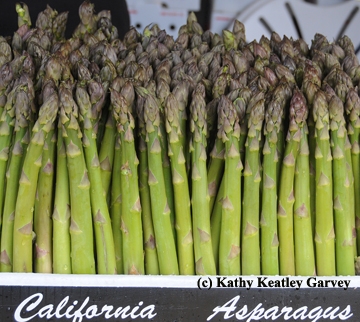 Asparagus is part of going green. There's also a white variety now. (Photo by Kathy Keatley Garvey)
Asparagus is part of going green. There's also a white variety now. (Photo by Kathy Keatley Garvey) - Shop the perimeter of the store: Marketing experts have placed the healthiest foods at the farthest corners of the store so that the shopper has to stroll through the other items before finding fruits and vegetables, protein sources (poultry, meats), dairy products and cereal products.
- Think protein: Buy meat and poultry on sale and use these foods to make stews, soups and chili. This way you can stretch these more expensive food sources. Beans are a great source of protein and are low fat and high in fiber.
- Plan meals ahead: The best way to save money is to plan your meals in advance. Buying unprocessed foods will improve your health and also save money. It costs to add preservatives, food additives and packaging of products that you, the consumer, are paying for. It's much cheaper to buy rice in bulk rather than already prepared rice products. Brown rice contains more fiber than white rice.
- Cook! Your grandmother was right. Food prepared from scratch will taste better, be healthier and save money. Research has shown that cooking not only saves money but improves nutrition.
- Enjoy! Food is meant to be a pleasant happy experience. Don't forget to enjoy it!
So, the next time you're racing out the door on your way to the supermarket, be sure to eat first so you're not tempted by foods that you know aren't good for you.
And that shopping list? You can also key that in on your cell phone so neither the list, nor your phone, will get left behind.
Meanwhile, we all ought to follow Amy Block Joy's great advice on saving money, eating green, and being healthier.
As I wrote on one of my college essays, "We have a choice in the matter and it matters that we have a choice."

The produce aisle is a good place to "go green and eat healthier." (Photo by Kathy Keatley Garvey)

Grocery stores usually place fruits and vegetables around the perimeter. (Photo by Kathy Keatley Garvey)
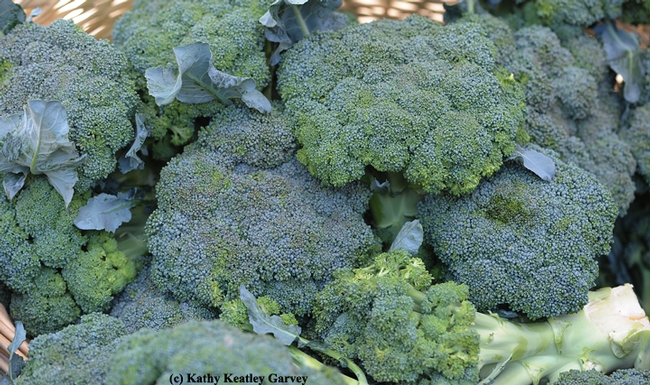
Broccoli--a food everyone should love. (Photo by Kathy Keatley Garvey)
